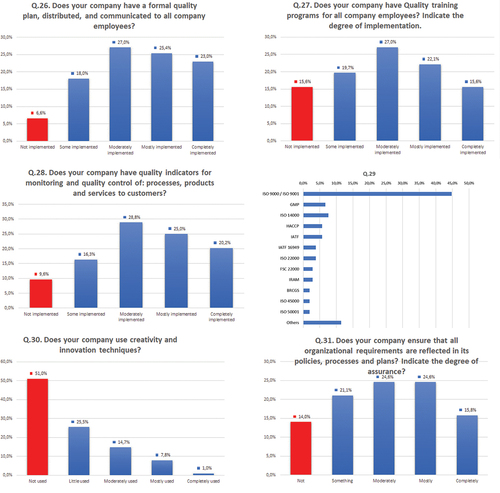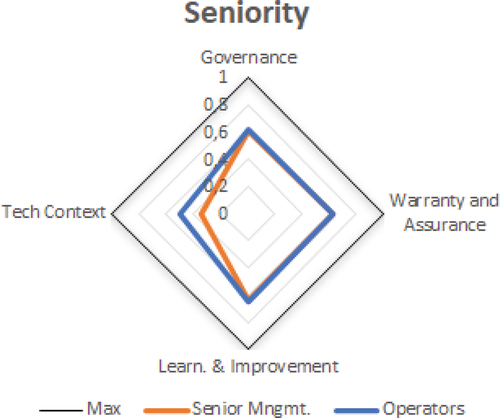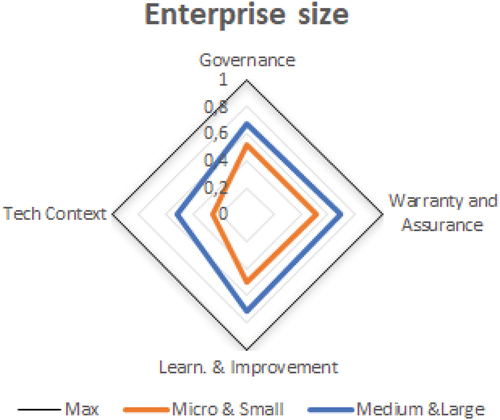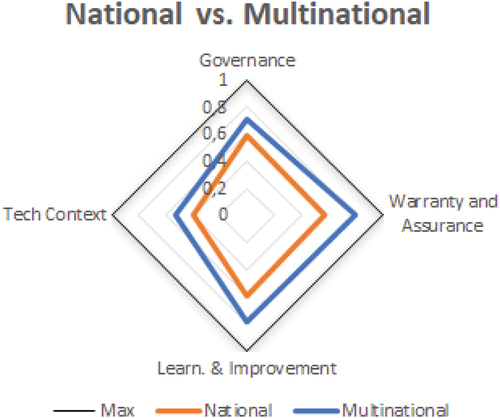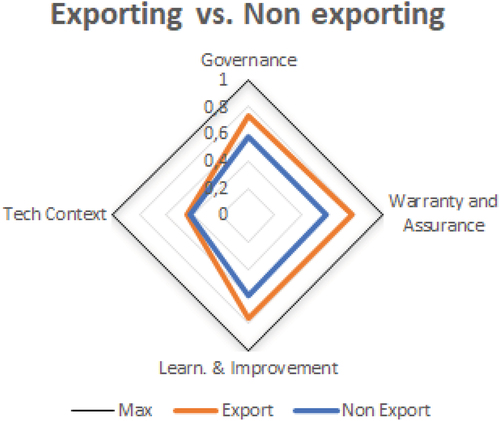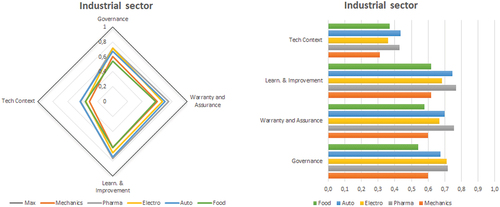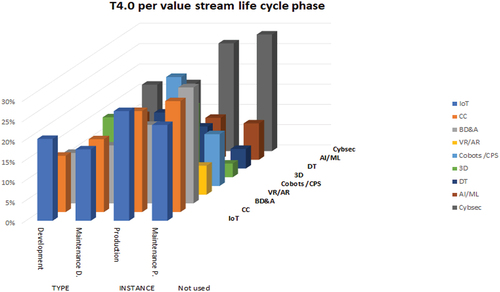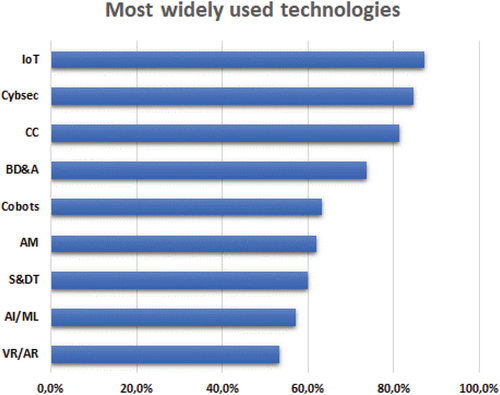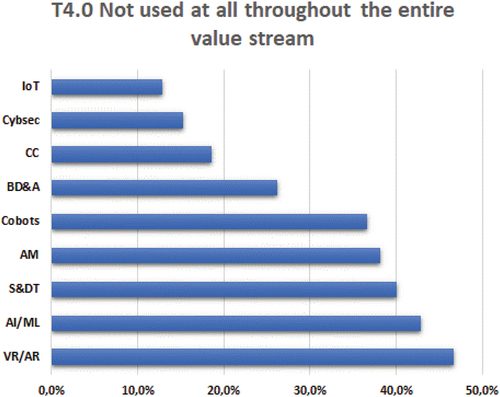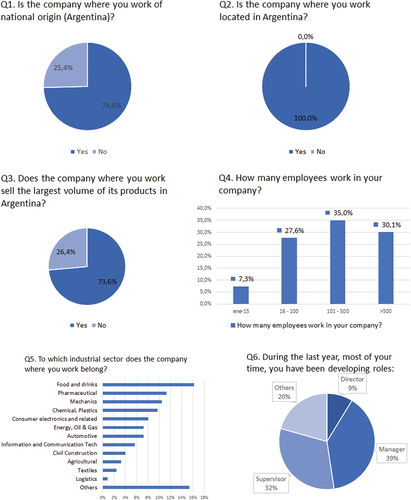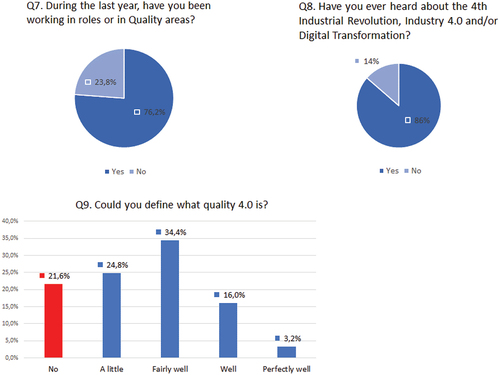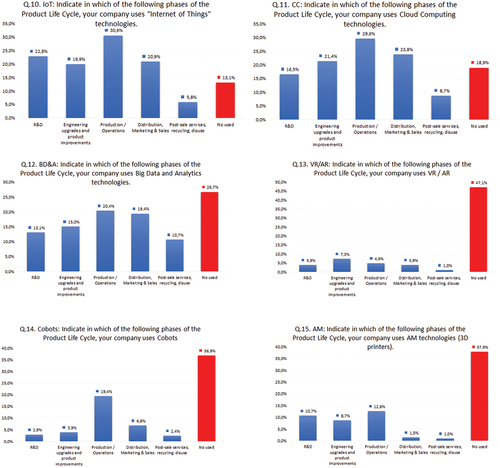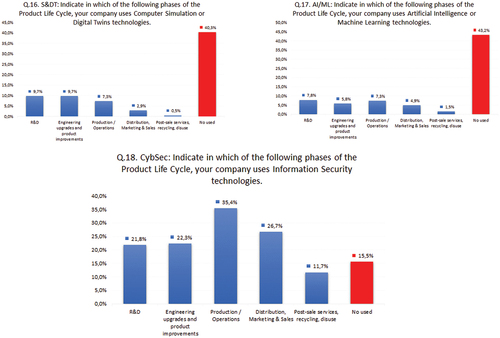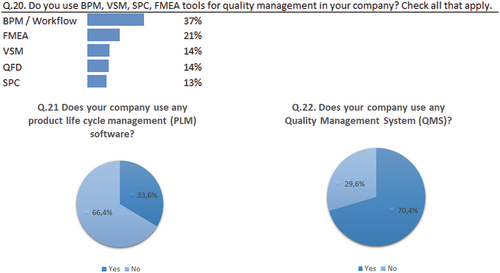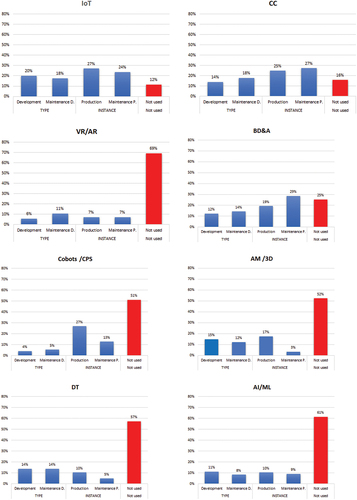 ?Mathematical formulae have been encoded as MathML and are displayed in this HTML version using MathJax in order to improve their display. Uncheck the box to turn MathJax off. This feature requires Javascript. Click on a formula to zoom.
?Mathematical formulae have been encoded as MathML and are displayed in this HTML version using MathJax in order to improve their display. Uncheck the box to turn MathJax off. This feature requires Javascript. Click on a formula to zoom.ABSTRACT
Due to the new enabling technologies, Quality Management has become data-driven management, allowing a systematic capture and analysis of quality data in real time. The purpose of this article is to present an empirical work about the impact caused by Industry 4.0 technologies on Quality Management through the entire enterprise value flow life cycle. A quantitative analysis was performed during August and September 2022 in Argentina. Findings indicate that medium and large companies make better use of new technologies for quality management, multinational ones are better qualified and pharmaceutical industry is the best prepared. The production phase is the one with the intensive use of new technologies, being IoT, Cybersecurity and Cloud Computing the most utilised. This is the first scientific study on influential technologies in Quality 4.0 in Argentina that empirically analysed Technologies 4.0 in each phase of the value flow life cycle.
1. Introduction
The emergence of the Internet has been causing innovative and radical changes led by Internet of Things (IoT), Artificial Intelligence (AI), Cloud Computing (CC) and Cyber-Physical Systems (CPS) merging the real world with the virtual one. Although those kinds of disruptive changes are generally better observed, analysed and studied after many years of having befallen, it can already be said that the 4th Industrial Revolution (4IR) is currently underway.
The 4IR signifies the era of IoT, AI and intelligent robots’ applications. Under this conception, objects and products control their own production, and communicate with machines and equipment through unique product codes during their manufacturing process (Kovács et al., Citation2019). That 4IR applied to manufacturing has been coined I4.0 and is giving rise to social, economic, and technological changes. Those enabling technologies, named Technologies 4.0 (T4.0), new techniques, tools, multidiscipline skills, training, and education are generating new concepts, disciplines and business opportunities such as Quality 4.0 (Q4.0), Services 4.0, Products 4.0, Workers 4.0 and Education 4.0, among others. It is also important to highlight the incipient beginning of another new concept: the I4.0 people-centered, which with the contemplation of the environment sustainability is beginning to be called Industry 5.0 (I5.0).
Among all those changes, Quality Management (QM) is also being impacted. The QM of the value stream life cycle (VSLC) must comply with new requirements imposed by the 4IR (Eng & Nikolova-Jahn, Citation2019). I4.0 allows the development of complex and non-predefined processes due to a network connection of its intelligent components seeking to improve time, quality, costs, safety and motivation (Enke et al., Citation2018). QM has become a data-driven management one due to the systematic capture and analysis of quality data in real time. It is a fact that the use of T4.0 has an impact, not only in the production stage, but in the entire life cycle of a product, making the vertical and horizontal integration of the value flow chain a reality Standarization-Council-Industry (Citation2020).
Although there are studies on the adoption of T4.0 in the industry, there is a gap in terms of its use by the enterprise’s quality responsible in the different phases of the VSLC. This research project analyses the degree of adoption of T4.0 by Argentine`s companies and its collaboration with QM practitioners throughout the four stages of the VSLC defined in the Reference Architectural Model Industrie 4.0. (RAMI4.0); it is the Q4.0 readiness in Argentina. This work corresponds to the fourth project within an I4.0 research program in Argentina ().
Because of that and during the following Theoretical Foundation, a brief description about T4.0, I4.0 readiness and Entry Barriers and Q4.0 is presented. It is of great interest to analyse how new technologies, hard and soft methodologies and tools will be managed in this new context and throughout the entire VSLC with the aim of ensuring the quality of products and processes.
For this aim, a quantitative analysis, via a survey of 34 questions n = 187, was carried out in Argentine, in which 129 complete and valid responses were obtained, in order to, first, evaluate the four main Q4.0 dimensions: Governance, Guarantee & Quality Assurance, Learning & Improvement and T4.0 context, and second, analyse the degree of adoption of each T4.0 in each phase and subphase of an enterprise VSLC; that is, IoT, CC, CPS and Cobots, Simulations and Digital Twins (S&DT), Big Data & Analytics (BD&A), AI, Additive Manufacturing (AM), Virtual Reality and Augmented Reality (VR/AR), and Cyber security (Cybsec).
The analysis was performed according to the RAMI4.0 in all its phases: Development, Maintenance of development, Production and Maintenance of production ().
Accordingly, the following research questions (RQ) were posed:
RQ1.
What is the degree of adoption of T4.0?
RQ2.
What is the degree of horizontal integration?
RQ3.
What is the degree of adoption of QM soft skills throughout the entire value stream life cycle?
It is worth noting again that the three RQ were exclusively focused on Argentine market.
This article is organized in the following way: after section 1, Introduction, in section 2, Theoretical Foundations, I4.0 concepts, technologies, readiness and barriers, VSLC and Q4.0 could be found. Then, in section 3, the Research Methodology is described. Section 4 is about survey results and discussions. Finally, conclusions and possible future research work are presented. At the end of this article, it could be also found an annex with more details about the results of this study.
2. Theoretical foundation
2.1. Industry 4.0
The I4.0 initiative was made public for the first time at the Hannover Messe in 2011 (Oluwaseun & Numbu, Citation2019; Qin et al., Citation2016; Rauch, Citation2020; Sanders et al., Citation2016). Three representatives from the world of business, politics and science, Henning Kagermann, Wolf-Dieter Lukas and Wolfgang Wahlster, showed how the industry paradigm was changing.
The term I4.0 describes the revolution in the manufacturing industry around the world. It is the combination of information technology (IT), operations and the Internet in manufacturing companies (Prause, Citation2019). It is the integration and interaction of technologies, both in the digital and physical world, that differentiate it from other industrial revolutions (Demartini et al., Citation2019). Smart objects communicate with each other creating the IoT. The physical world and the virtual world are integrated into CPS (L. Sommer, Citation2015). I4.0 is the revolution of the entire value chain process in manufacturing based on the cyber-physical production system (Kowang et al., Citation2019).
At the Industrial Internet Consortium 2017, I4.0 was defined as the integration of complex physical machinery and devices with networked sensors and software used to predict, control and plan for better business and social outcomes (Maresova et al., Citation2018). On the other hand, Kagermann (Citation2015) defines it as a new level of organization of the value chain and management throughout the life cycle of the products. According to Mosterman and Zander (Citation2016) I4.0 could be synthesized in three pillars: (1) digitisation of production, (2) automation and (3) automatic data exchange.
I4.0 is characterised by nine key technologies: (1) advanced manufacturing/collaborative robotics, (2) additive manufacturing, (3) simulation, (4) augmented reality, (5) horizontal and vertical integration, (6) IIoT, (7) CC, (8) cybersecurity and (9) Big Data and Analytics (Rauch & Vinante, Citation2021). On the other hand, and according to L. Wang et al. (Citation2021), AI has a key importance in the product life cycle management, and that is the reason why it has also been considered into this work as the tenth enabling technology.
According to some researchers the size of the company matters when it comes to implement I4.0. The inadequate infrastructure of the company and the skills of the personnel that must carry it out could also be the root-cause of this effect. The willingness and ability to meet this challenge exists in parts, however, it is strongly dependent on the size of the company. There is a concern that the redundant effect of I4.0 will dominate in the long term, leading to what is known as technological unemployment (Roblek et al., Citation2016).
Current studies, mainly in Germany, verify the improvement in enterprises productivity because of their digitisation and automation. It was said, in 2015, that during the following 5 to 10 years I4.0 would be adopted by more companies, which would increase productivity in all German manufacturing sectors (Logunova et al., Citation2020; Rüßmann et al., Citation2015).
2.2. Enabling technologies
2.2.1. Internet of things
The IoT is the main enabling technology of the I4.0. It is the network of physical objects or things integrated with electronics, software, sensors, and connectivity, which allow them to collect and exchange data (Bisio et al., Citation2018). The IoT applied to industries is named Industrial IoT (IIOT) (Karmakar et al., Citation2019).
2.2.2. Cloud computing
It is a general term that refers to the delivery of computing services through visualised and scalable resources over the Internet (Zhong et al., Citation2017). Instead of satisfying hardware and software needs inside the same company, they do it externally (Zhou & Liu, Citation2015). It ensures the access to configurable resources that can be quickly managed with minimal interaction using Internet infrastructures (Oluwaseun & Numbu, Citation2019). In the industrial sector, CC facilitates access to all production machinery and equipment by providing data storage through the network (Ates et al., Citation2020).
2.2.3. Cyber physical systems
CPS involves designed computing and communication systems that interface with the physical world. It seamlessly integrates computing with physical processes, providing abstractions, modelling, design and techniques for the integrated whole requiring computing and data networking technologies. CPS requires a two-way interaction between the digital and physical worlds (Neal et al., Citation2021).
2.2.4. Collaborative robots
Robotics technology has transformed the manufacturing industry since the appearance of the first industrial robot in the early 1960s. The challenge of developing flexible solutions remains a challenge (Kragic et al., Citation2018). Productivity must be improved, and manufacturers cannot ignore the pace that significant and measurable progress is required in I4.0 Esben (Citation2017). The real revolution is the use of robots as people`s collaborators, that is, Collaborative Robots or Cobots. According to the authors Gualtieri et al. (Citation2021) the advantages of collaboration between humans and robots are the improvements of working operators´ conditions due to safety care, the superior use of production areas because of the lack of physical barriers, the accessibility to work areas, production capacity, quality and the availability of the more specialized labour force.
2.2.5. Simulation and digital twin
The development of new computer simulation methods is very important to increase competitiveness (Gajsek et al., Citation2019). They are used in manufacturing systems to cutback costs, curtail risks and boost speeds. Simulation lives in the era of the DT favouring constant support for decision-making (dos Santos et al., Citation2021). Duan and Tian (Citation2020) highlight that the fundamental characteristic that differentiates a DT from a traditional simulation is the real-time bidirectionality of monitoring and control data between the physical and virtual objects. They are compounded by physical entities in the physical world and virtual models in the virtual world (Qi & Tao, Citation2018). DT encompasses much more than the mere reproduction of existing assets combining the notions of DT, digital master and digital prototype (Lutters, Citation2018).
2.2.6. Big data and analytics
With the great momentum of the IoT, data is becoming more accessible in many industries resulting in a problem of handling large volumes. It comes from multiple channels, including sensors, devices and networks. BD is a term applied to data sets whose size is beyond the capacity of traditional relational databases (Gautam & Singh, Citation2018; Lee et al., Citation2018). Besides that, analytics is complex field that involves statistical analysis and computational linguistics with the goal of discovering patterns and meaningful insights (Szabó-Szentgróti et al., Citation2021).
2.2.7. Artificial intelligence
In the context of the I4.0 paradigm, AI is considered nowadays as one of the keys enabling technologies to achieve capabilities and disruptively redefine the way manufacturing processes and business models are structured (Peres et al., Citation2020). AI seeks to emulate natural intelligence and perhaps machines will be able to match and even surpass human intelligence (Acosta, Citation2019). It is important to stand out Machine Learning (ML), a subset of AI. ML is the generation of knowledge since the experience of previous examples, which once analysed by means of algorithms can be applied to predict new data of the same type. It is a very strong trend, both in research and in industrial applications (M. Sommer & Stjepandić, Citation2022).
2.2.8. Additive manufacturing
AM is a process that takes a digital representation in three dimensions and manufactures the associated physical object by adding small layers, one after another, until the physical object is finished (Kuila et al., Citation2021). Unlike traditional subtractive manufacturing techniques, AM is a constructive manufacturing method whereby layers of corresponding materials are deposited together under certain conditions to shape the final product (Azarian et al., Citation2021). The original 3-dimension digital model is converted into digital files which are cut into thin horizontal layers which are the source images for 3D printers. In that way, AM allows the production of objects with complex geometries very difficult or almost impossible to achieve by any other subtractive manufacturing technology. Because of its speed, flexibility, quality and low cost, AM is used especially in the production of customized products, prototypes, special components and machine spare parts (Ates et al., Citation2020).
2.2.9. Virtual reality and augmented reality
Virtual Reality (VR) is an experience that places the user into a simulated environment designed to reproduce the feelings experienced in real life. The authors Bhosale et al. (Citation2018) states that while VR immerses the consumer in a virtual life, AR combines the real world with computer visuals. These technologies are beginning used, among others, for personnel`s training in shop floors.
2.2.10. Cybersecurity
Information security is the discipline that deals with the protection of data contained in a computer, networks or in the cloud, that is, in any computer system.
I4.0 is generating a social change in many areas and the field of crime is also one of them. That is because profitability, in this new I4.0 environment, is expected to motivate criminals to act on their own behalf. The resulting criminal environment is expected to gradually increase the role of cybersecurity. Ates et al. (Citation2020) states that I4.0 can be examined from seven different perspectives when talking about security, they are: (1) security of BD and Cloud Storage Systems, (2) Cyber espionage, (3) digital forensic analysis, (4) Cyberterrorism, (5) security of the supply chain, (6) security of IoT and (7) Regulations.
2.3. Industry 4.0 readiness and entry barriers
2.3.1. Industry 4.0 readiness in Argentina
When wanting to study the degree of adoption of T4.0 used for QM, it is also important to know the general status of I4.0. Although there were several studies and models analysing companies’ readiness and maturity models in different countries around the world, Argentina was still lacking an in-depth study of that type, mainly for the SMEs (Salimbeni, Citation2019). In line with said international models, that research showed that the I4.0 readiness factor in Argentine Enterprises was 2.5 (on a scale 0 to 5, where 0 stipulated no use of T4.0 at all, and 5 the use of all available T4.0s.). It indicates that I4.0 development is still halfway through. In that same study, Information Systems was the best performed while Smart Manufacturing was the worst one. When analysed according to the size of the enterprises, a marked difference was confirmed in the development of medium and large companies with respect to micro and small ones. An overview of the I4.0 situation in Argentina is illustrated in . Despite the importance of this study, it had not been analysed the degree of integration of T4.0 throughout the VSLC, which is of fundamental importance for Total Quality Management (TQM).
Figure 3. I4.0 readiness in Argentina. SMEs vs. Large Companies. Source: Salimbeni (Citation2021).
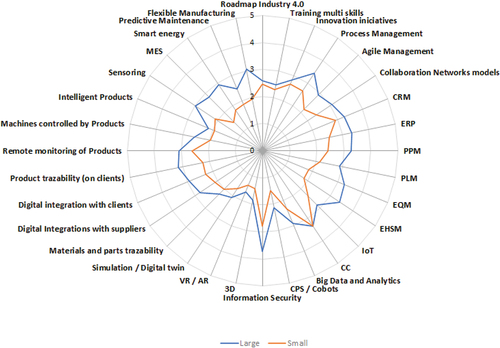
2.3.2. Industry 4.0 entry barriers in Argentina
Several challenges must be faced on the road to I4.0, such as high implementation costs, organisational and process changes, security and data protection and the need for qualified personnel at all organisational levels who can deal with the growing complexity of future information systems and production (Kumar et al., Citation2021).
Based on prominent researchers` models (Dikhanbayeva et al., Citation2021; Essakly et al., Citation2019; Fayomi et al., Citation2020; Genest & Gamache, Citation2020; Horváth & Szabó, Citation2019; Huang et al., Citation2019; Ingaldi & Ulewicz, Citation2020; Kruszewska et al., Citation2021; Kumar et al., Citation2021; Mezentseva, Citation2021), an analysis about I4.0 barriers was performed in 108 Argentine companies evaluating entry barrier factors (Gutnisky & Salimbeni, Citation2022). That work showed that there were two very important entry barriers in Argentina, Lack of specialized Human Resources and Lack of roadmap and planning. That study also concludes that Inadequate Business Model is not so strong. It also indicated that, in case of micro and small companies, a higher entry barriers index is noted. It is also stated that when companies of national origin (Argentine) were compared to those of Multinational (foreign) origin, it cannot be affirmed that there was a difference between them. A summary of those results can be seen in .
Figure 4. I4.0 Entry Barriers in Argentina. Source: Gutnisky and Salimbeni (Citation2022).

2.4. Value stream life cycle
I4.0 needs to establish standards for digitised industrial production, such as communication network structures, communication protocols and cybersecurity rules. For this purpose, a three-dimensional model has been developed as a Reference Framework for the I4.0 Architecture (Pessl et al., Citation2020)). RAMI4.0 has three standardized dimensions: (1) Layers, (2) Life Cycle & Value Stream, and (3) Hierarchy Levels (). Each company has a series of activities which make up its processes and must add value, that is the so-called Value Stream. In turn, each organization has its suppliers and customers, who also have their Value Stream; this set constitutes the so-called Value System. The Value Stream of a company is represented by a life cycle where several phases which the components and end-products circulate. The RAMI4.0 represents this VSLC in two main phases called: (1) Type and (2) Instance. At the same time the Type phase has two subphases: (1.1) Development and (1.2) Maintenance, and the Instance phase also has two ones: (2.1) Production and (2.2) Maintenance.
Figure 5. Reference architecture model for the industry 4.0. Source: German Standardization Roadmap Industrie 4.0 version 4.
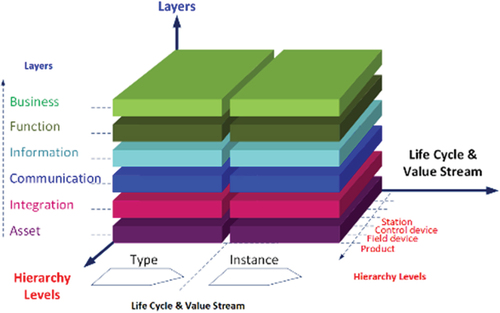
For instance, an engine manufacturer in the (1.1) Development subphase is made up of all the design and development steps of a new product, while the next subphase, (1.2) Maintenance, refers to the design updates of such a product. The (2.1) Production subphase refers to the manufacture of that engine, while the (2.2) Instance`s Maintenance subphase refers to the upkeep of the production system and the after-sales services the which is being used by the end user. The understanding of each stage of that VSLC is very important for this research work since the evaluation of T4.0 adoption has been carried out individually for each of those four stages.
2.5. Quality 4.0
The quality of products, services and processes is nowadays essential to achieve sustainable economic success and ensure business competitiveness; that is because QM attracts the interest of many professionals and academics (Foidl & Felderer, Citation2016).
TQM maintains its origins, but, as results of digitization, the quantity, reliability and speed with which data is captured and analysed offers much more accurate and real-time information that changes the paradigm of QM, allowing, among others, the best decision making (Demartini & Tonelli, Citation2018).
Digital Transformation (DX) has witnessed this new evolution in quality, imposing a greater use of data to speed up decision-making by quickly studying the root-causes and, because of that, also being able to carry out predictive analysis (Antony et al., Citation2022).
Quality has evolved from Inspection through Control, Assurance, TQM and Design for Quality, but, in recent years, the advent of T4.0 has produced a significant leap in its evolution (Zonnenshain & Kenett, Citation2020). Quality, in the 4IR, comes with the objective of combining QM with the new I4.0 capabilities, all with the aim of helping organisations to achieve organizational excellence; this is the so-called Q4.0 (Frank et al., Citation2019). Q4.0 is the use of technology together with people in order to improve the quality of an organization, its processes, products and services. It combines T4.0 with traditional methods, with the intention of reaching new levels of operational excellence, performance, and innovation (Aldag & Eker, Citation2018). The use of data analysis and prediction systems, software with the ability to self-adjust processes based on the data, the availability of timely and accurate data, and the use of data processing software is what distinguishes Q4.0 from the traditional one (Yadav et al., Citation2021). Another matter to highlight is that the most notable difference between Q4.0 and the traditional one lies in the new opportunities that are generating from Horizontal Integration throughout the VSLC (Chiarini & Kumar, Citation2020).
Four main areas are often emphasized in Q4.0: (1) design and development, (2) production, (3) service and (4) company culture. The first three ones are addressed in detail by RAMI4.0, but, according to Nenadál (Citation2020) one last element is added, business culture, which must be considered especially for organizations´ environment. For their part, Salimova et al. (Citation2020) state that the concept of Q4.0 is defined as the adaptability of products or services in all stages of the VSLC. It is done to meet the needs of a specific consumer through partnerships with stakeholders and digital management of the value chain. Q4.0 is based on bridging the gap between consumer requirements and product specifications, which arise due to the need to tailor mass products to meet individual needs (Hüseyin et al., Citation2018).
Zonnenshain and Kenett (Citation2020) conclude that there is not yet a clear definition of Q4.0, but they stand out the following guidelines which are relevant to this research work. They state that Q4.0 is a data-driven discipline, promote modelling and simulation for evidence-based quality, strength health monitoring and quality forecasts, integrate QM, depends on I4.0 maturity levels, seeks to integrate innovation with quality and management for innovation, it is linked to data science, seeks to integrate reliability engineering with quality engineering and finally, improves the quality of information. Those authors ensure that they are aware that those directions are not yet a complete picture of Q4.0, however, they proclaim that constitute a substantial basis for updating the body of QM knowledge and practice.
On the other hand, according to Carvalho et al. (Citation2021), quality could be summarized in two basic dimensions, technical aspects and behavioural ones, which in turn express different QM practices and the impact of T4.0. Fonseca et al. (Citation2021) highlights the Simulation and Virtualization as one of the great benefits of I4.0. Finally, Milunovic Koprivica et al. (Citation2019) assert that the new Q4.0-Plus model should include quality of life, particularly the quality of working life, positive psychology, and virtual quality because the virtual environment in the future will be dominant and this new concept would be the so-called Quality 5.0 (Q5.0).
Due to those all those previous concepts, this research work analyses the impact and the degree of adoption of the T4.0 on QM throughout all the stages of the VSLC.
3. Research methodology
The design and approach of this Q4.0 research, in its qualitative phase, follows a Grounded Theory; the theoretical propositions raised from the data obtained in the research. The specific design was systematic and the procedure was by open coding. The methodology was based on a mixed approach and, fundamentally, from the perspective of Industrial Engineering. The scope of the research was exploratory and descriptive, with participant observation and a structured questionnaire. Regarding the design, it was transactional and exploratory type for the study of the factors of specific objectives.
The methodology for the Q4.0 theoretical framework was that of a Systematic Literature Review (Schmeisser, Citation2013) with reading, mapping, open coding method and bibliometrics. The Mendeley™ bibliographic management tool, VOSviewer™ bibliometrics, and MAXQDA™ qualitative tools were used. Excel™ and Minitab™ for statistical analysis. The evaluation, collection, analysis and development were carried out according to the three research questions.
3.1. Units of analysis and response
Qualitative stage: as a response and analysis unit, 7 Argentine manufacturing companies were selected respecting segmentation by industry and company size; it was carried out as a complementary help tool for the subsequent construction of the instrument for the quantitative study. Quantitative stage: representative statistical samples of Argentine industrial companies were taken as the unit of analysis. Response unit: supervisors, managers, and directors. Roles related to quality management were exclusively selected.
3.2. Data collection techniques, processing, and analysis
The survey was conducted during August and September 2022. During some statistical tests, the extreme categories of each five-point scale of the independent variables were grouped in order to avoid observed undercounts, thus increasing their precision.
Limitations: data about years of experience in the position, gender and age of the respondents were not collected. Therefore, it is not possible to examine to what extent these personal data influence the results.
Techniques. Qualitative stage: in-depth interviews. They were carried out in manufacturing companies belonging to different sectors of the industry. Quantitative stage: 388 surveys with self-managed forms were supplied through the digital platform e-encuesta™.
Samples. Qualitative stage: the theoretical sampling strategy was utilised to select the industries, companies and people to interview. Quantitative stage: the survey was administered to a group of industries/people called the sample, with the aim of identifying trends in attitudes, opinions, behaviours or characteristics of a larger group of individuals called the population. To gather the data, the following sequence was followed: (i) the survey was sent to 388 contacts; (ii) it was expected to obtain at least 100 complete and valid responses to the surveys.
3.3. Processing and analysis
Qualitative stage: MAXQDA2020™ qualitative analysis tool was used to analyse data from in-depth interviews, such as texts, images, audio and video files. Quantitative stage: the e-encuesta™ platform was used to carry out on-line surveys generating a data matrix of the responses. It was converted to spreadsheets for further processing. The quantitative analysis was complemented by the use of MS Excel™ and Minitab™ as statistical and graphical tools.
3.4. Quality 4.0 survey tool
This survey tool was the questionnaire which serve as the primary source of data on given respondents and it corresponds to the application of the Reference Framework for Q4.0. It is summarized in the following . It can be seen the characterization questionnaire in Table 8 in the annex.
Table 1. Methodology survey. Quality 4.0 in Argentina.
As explained in the theoretical framework, the RAMI4.0 recommendation was followed for the study of the different phases and subphases of the VSLC. The classification of the life cycle of a product within the recommendation is detailed in Table 9 in the annex.
4. Survey results and discussion
4.1. Quality 4.0 survey results
Questions 1 to 9 were used to characterize the respondents ().
Table 2. Questionnaire Q1 to Q9 - Characteristics of Survey Respondents.
The most important findings were the following (all graphs available in the annex in and ).
Q1.
Almost 75% of the companies surveyed were of Argentine origin being Multinational the missing ones.
Q2.
The 100% of the companies surveyed were located in Argentina. Because the study was focused on Argentina, this question was asked to validate the origin and no company located abroad would enter by mistake.
Q3.
It was very important to know the export or non-export profile of the companies surveyed. It was due to one assumption that those exporting companies would have better technological infrastructure and good practices than those which operate locally. Almost 75% of the companies surveyed supply their products mainly locally and not so much abroad.
Q4.
Regarding the size of the organizations surveyed, the one with the greatest representation were medium-sized companies with a 35% share.
Q5.
Argentina stands out for its agro-industrial production. Due to this, it is not surprising that the segment with the highest participation in the survey is food and beverages, followed by the pharmaceutical industry. The sample is also representative in terms of industrial sectors.
Q6.
It was also important to study in this research the role of each respondent since one of the assumptions was that the higher the position held, the broader the knowledge of the complete value chain of the company would be.
Q7.
Considering that the survey was about QM, and it is known that in Argentina, at least, this discipline is not always solely in the hands of Quality Area Managers, it was decided to focus on whether the respondent performs tasks related to Quality Management beyond their role during the last year. This allowed one to know if the person surveyed could be updated or not on the matter subject under study.
Q8.
The strategy was also to know if the person surveyed could be aware of new technologies and practices, and that was the reason they were asked if had heard about 4IR, I4.0 or DX. Results showed that almost 86% did.
Q9.
In accordance with the previous question, the respondent was approached asking him/her if was able to define what Q4.0 was. This could offer a hint of the professional’s degree of knowledge on those issues. Almost 21% answered that did not know.
Questions Q10 to Q18 explored the intensity of use of each T4.0 in each of the previously defined stages ().
Table 3. Questionnaire Q10 to Q18 – Technologies 4.0 and VSLC.
In a first approach, it can be seen that IoT, CC, BD&A and Cybsec are more utilised. From the VSLC point of view, a greater intensity of use is also observed in the Production phase. It is also notorious that the use of VR/AR, Cobots, AM, S&DT and AI/ML is just incipient. It can be seen the detailed results in the annex and . Q19. As already was explained in the introduction, one of the most important features of I4.0 is the Horizontal-Integration. That is, the possibility of carrying out a complete end-to-end traceability throughout the entire VSLC, it is, from the product design and arrival at the factory of the components to the disuse of the final product by the end user. It was the reason for question Q19. Although the results appear to be promising, care should be taken into consideration since it was also verified that there is not a full understanding of the Horizontal-Integration concept as defined in RAMI4.0 (annex ).
Q20 to Q22. At this point, the questionnaire is focused on QM traditional techniques and tools ().
Table 4. Questionnaire – Quality Management Tools.
It was also sought to know the use of two types of management software tools, both the product life cycle and quality management. Approximately a third of those surveyed use PLM software and fewer still use QMS. Detailed results can be seen in the annex ().
Three complementary questions () were asked to complete the necessary data to understand the Smart Production (SP) status. To achieve that, a direct question was not resorted but indirectly three ones about the most important characteristics of SP.
Table 5. Questionnaire – Smart Production.
Once again, it is concluded that less than 3 out of 10 of the surveyed companies have some characteristic compatible with SP. The detailed results can be observed in the annex . Q26 to Q34 are Organization and People dimension questions and are shown in . The corresponding results can be observed in the and .
Table 6. Questionnaire – Organization and people.
Finally, and in order to analyze the soft QM factors, the data were synthesized and organized into the four corresponding groups, as defined in the following .
4.2. Discussion
4.2.1. General analysis according to the four dimensions
The first analysis carried out, based on the results of the Q4.0 survey, consists of evaluating the responses based on the four defined dimensions. As previously stated, the CQI (Chartered Quality Institute) establishes the use of digital technologies in QM to effectively offer governance, guarantee and continuous improvement. In summary, the dimensions considered were Governance, Guarantee & Quality Assurance, Learning & Improvement and Technological Context. Then, observing and , it could be concluded that among the surveyed senior management and operational personnel, a slight difference in operational personnel favor is observed in the perception of the technologies used, coinciding almost exactly in the other dimensions. In any case, it can be observed, according to the respondents, a scarce application of the new technologies for quality assurance.
On the other hand, when the responses are analyzed based on the size of the companies, an important difference is observed in favor of the large ones ().
The following figures shows the responses based on the origin of the companies, in turn, it shows whether they are mainly exporting companies or not. In summary, it is observed that Multinational companies score better in all four dimensions than those Argentines. This is probably due to the requirements of international norms or standards, not mandatory in Argentina ().
Companies with an export profile also qualify better in the four dimensions than non-exporters. It can be due, almost certainly, to the demands of the international markets and the competition regarding quality in general terms (). Note that the difference is not so important in technologies but in their application to Quality Management.
An analysis of the most representative industries sectors of the sample taken for the survey can also be seen (). From them, it can be concluded that, in line with what was expected due to what was analyzed in the bibliographic research, the pharmaceutical industry qualifies a little better in the four dimensions, equaling its qualification with the automotive industry in relation to the use of technology.
In contrast to that, the Argentine food and metalworking industries are among the worst rated. In any case, it is not possible to conclude definitively until each individual factor has been analysed in detail. One hypothesis would be that the significant share of SME in the food sector, which is the case of Argentina, has a very strong craft and family component, and as seen above, lack sufficient development in terms of QM.
4.2.2. Analysis according to the value stream life cycle
T4.0 used in each phase and subphase of the VSLC are analyzed below in accordance with the recommendations of the RAMI4.0. Performing an analysis and considering the role of the respondents, it could be concluded that at least one out of three companies do not use any T4.0 throughout the entire VSLC. There is, once again, a divergence from the perspective of senior management regarding the operating ones, although non-use undoubtedly prevails as can be seen in the previous graph. Note also that there is a greater use, although not very important, of T4.0 in the production phase ().
When results are breakdown by company size, it can be clearly seen the difference in terms of ‘not used at all T4.0’ throughout the entire Value Stream. Besides that, there is once again, in both cases, an incipient increase in use in the Production subphase ().
Considering the local or foreign origin of the surveyed companies, it is observed again a considerable advantage by multinationals ones in the use of T4.0. Also note that a ‘not used at all T4.0’ is significantly lower in companies of foreign origin ().
Regarding the exporting companies there is a greater use of T4.0 in all their phases and a lower frequency of non-use in any phase of the VSLC ().
4.2.3. Industrial segment analysis
According to the statistical relevance, and in line with the industries of interest for this work, the results of the industrial sectors analysed were mainly mechanics, pharmaceuticals, electronics, automobiles, and food & beverages. It is concluded, based on the results, that the Production Phase is making the most intensive use of T4.0. On the other hand, the ‘not used at all the T4.0’ is most notorious in the Mechanical sector, followed by Food & Beverages, whose reason again stems from the strong share of SMEs in said industrial sector ().
4.2.4. General analysis of T4.0 utilisation
During an overall analysis it could be said that, on average, Information Security is used in 44% of the VSLC, followed by CC and IoT with 39% and 37% respectively. The average intensity of use of each technology is shown in .
Figure 18. VSLC analysis by average use of T4.0.
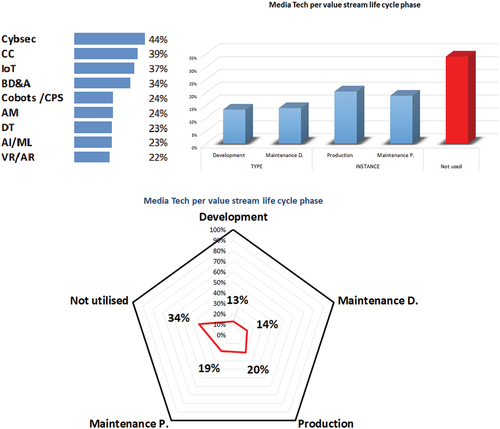
There were surveyed nine technologies and four phases for quality management, namely, (i)Technologies (Tc): IoT, CC, BD&A, VR/AR, Cobots/CPS, 3D, DT, AI/ML, Cybsec and (ii) Phases: Development, development maintenance, Production, production maintenance. A total count of all possible technologies was made in all phases. The percentage of current and actual utilization with respect to the maximum possible was calculated. The valuation methodology considered for this analysis was as follows:
where n = 129 is the sample, and
Tc = 9 possible technologies to use for quality management: (1) IoT, (2) CC, (3) BD&A, (4) VR/AR, (5) Cobots/CPS, (6) 3D, (7) DT, (8) AI/ML and (9) Cybsec.
For instance, each of the 129 respondents were asked if they used IoT for quality management in the R&D stage, which 47 answered affirmatively, this means that IoT adoption for that phase is 47/129, that is 36.4% do use it. Another example, in the case of VR/AR, 8/129 use it, that is, only 6.2%. Extending this analysis to the nine evaluated technologies, 13.3% of those surveyed use some type of T4.0 for their R&D phase.
The results of said analysis are detailed and shown T4.0 utilisation per phase in the following .
Table 7. T4.0 utilisation per phase.
The previous results were also plotted and shown in .
Finally, it can be seen the intensity of use of each T4.0 in each phase of the VSLC ().
For a greater comfort for the analysis, same results are represented in a heat map ().
The most used technologies that facilitate Q4.0 in the national industry (Argentine) are IoT, Cybsec and CC (). The results coincide when asking the reverse, it means, which technologies are not used in any of the four phases of the VSLC ().
The nine detailed graphs of each technology in each of the four phases of the life cycle can be seen in the annex ().
5. Conclusions
After analysing the results of the survey, the three initial research questions could be answered as follows:
RQ1.
What is the degree of adoption of T4.0? From the survey it is concluded that 66% of the respondents use some kind of T4.0 in some of the phases of the VSLC in relation to quality management.Then, the most utilised technologies that facilitate Q4.0 in the Argentine industry are Cybsec, CC and IoT. For its part, the analysis shows that between 30% and 40% of the surveyed companies (depending on the role of the respondent) do not use any of the technologies called T4.0 throughout the entire VSLC.
RQ2.
What is the degree of horizontal integration? It could also be concluded that at least one out of three companies do not use any kind of T4.0 throughout the entire VSLC. There is, once again, a divergence from the perspective of senior management regarding the operating ones, although the non-use undoubtedly prevails. It also can be noted there is a greater use, although not very important, of T4.0 in the Production subphase. When analysing the results classified by company size, it can be clearly realized the difference in terms of ‘not used at all T4.0’ throughout the entire VSLC. Small businesses have a high degree of non-use of technology, although there is an incipient greater use in the Production subphase, followed by maintenance and use.
RQ3.
What is the degree of adoption of QM soft skills throughout the entire value stream life cycle? The degree of adoption, in terms of soft dimensions, is: (i) Learning and improvement, 64% (ii) Guarantee and continuous quality assurance, 63%, (iii) Governance, 61% and (iv) Technological, 49%. It is important to highlight that there is no significant difference between the opinion of top management and operators. In any case it can be observed a scarce application of the new technologies for quality assurance. When the responses are studied based on the size of the companies an important difference, again, can be observed in favour of the large one and in the four dimensions: Governance, Guarantee & Quality Assurance, Learning & Improvement and Technological Context. Besides that, multinational companies score better on all four dimensions than those of national origin. As already was explained, it is probably due to the requirements of international regulations or standards, which are not mandatory in Argentina. Precisely, considering the local or foreign origin of the companies surveyed, it is observed again a considerable advantage in the use of T4.0 by multinationals enterprises. In regard to firms with an export profile, also score better on all four dimensions than non-exporters. This can be certainly due to the demands of international markets and competition in relation to Quality in general terms. It is noted that the difference is not so important in T4.0 in general, but in their application to QM. Regarding industrial sectors, and in line with what was expected due to what was analysed in the bibliographic search, the pharmaceutical industry is the one that best qualifies in the four dimensions, equalling its qualification with the automotive industry in terms of the use of T4.0. In contrast to this, the Argentine food and metal-mechanic industries are among the worst rated. In any case, it is not possible to conclude definitively until the components are analysed in detail. One hypothesis would be the important share of SMEs in those industrial sectors, which in the case of Argentina has a very important artisan and family component, lacking sufficient development in terms of resources for QM. It is concluded, based on several results, that the production sub-phase is the one that is making the most utilisation of necessary T4.0 for QM.
In summary, and since the 129 valid responses, it could be finally concluded that: (i) medium and large companies are better prepared and organized for quality assurance and with the use of new technologies, (ii) companies with an export profile and multinationals are also better qualified, (iii) pharmaceutical industry is the best prepared, while the metal-mechanics industry qualifies among the least prepared amongst the industrial sectors surveyed, (iv) the phase with the highest incorporation of technology, although still poor, is the production sub-phase and (v) the enabling technologies with the greatest general use are: Cybersecurity, CC and IoT.
Disclosure statement
No potential conflict of interest was reported by the authors.
References
- Acosta, M. (2019). Inteligencia artificial: la cibernética del ser vivo y de la máquina. Naturaleza y Libertad Revista de Estudios Interdisciplinares, 12(12), 13–35. https://doi.org/10.24310/natylib.2019.v0i12.6262
- Aldag, M. C., & Eker, B. (2018). What is Quality 4.0 in the Era of Industry 4.0? International Conference on Quality of Life, 31–34. https://www.researchgate.net/publication/329442755_WHAT_IS_QUALITY_40_IN_THE_ERA_OF_INDUSTRY_40
- Antony, B. J., Bhat, S., Jayaraman, R., Mcdermott, O., Sony, M., Snee, R., & States, U. (2022). The genealogy of Quality 4.0. ISE Magazine, 34–40. www.iise.org/ISEmagazine
- Ates, E., Bostanci, E., & Guzel, M. (2020). Security Evaluation of Industry 4.0: Understanding Industry 4.0 on the Basis of Crime, Big Data, Internet of Things and Cyber Physical Systems. Güvenlik Bilimleri Dergisi, February, 29–50. https://doi.org/10.28956/gbd.695889
- Azarian, M., Yu, H., & Solvang, W. D. (2021). Integrating Additive Manufacturing into a Virtual Industry 4.0 Factory. In Lecture Notes in Electrical Engineering (Vol. 737, pp. 587–594). Springer Singapore. https://doi.org/10.1007/978-981-33-6318-2_73
- Bhosale, S., Patil, R. B., & Karjulkar, J. (2018). Augmented Reality. 2018 Fourth International Conference on Computing Communication Control and Automation (ICCUBEA), Pimpri Chinchwad, 36–48.
- Bisio, I., Garibotto, C., Grattarola, A., Lavagetto, F., & Sciarrone, A. (2018). Exploiting context-aware capabilities over the internet of things for industry 4.0 applications. IEEE Network, 32(3), 108–114. https://doi.org/10.1109/MNET.2018.1700355
- Carvalho, A. V., Enrique, D. V., Chouchene, A., & Charrua-Santos, F. (2021). Quality 4.0: An overview. Procedia Computer Science, 181(2019), 341–346. https://doi.org/10.1016/j.procs.2021.01.176
- Chiarini, A., & Kumar, M. (2020). Lean Six Sigma and Industry 4.0 integration for Operational Excellence: Evidence from Italian manufacturing companies. Production Planning and Control, 32(4), 1–18. https://doi.org/10.1080/09537287.2020.1784485
- Demartini, M., Evans, S., & Tonelli, F. (2019). Digitalization technologies for industrial sustainability. Procedia Manufacturing, 33, 264–271. https://doi.org/10.1016/j.promfg.2019.04.032
- Demartini, M., & Tonelli, F. (2018). Quality management in the industry 4.0 era. Proceedings of the Summer School Francesco Turco, Bergamo, 20187-Septe, 8–14.
- Dikhanbayeva, D., Tokbergenova, A., Lukhmanov, Y., Shehab, E., Pastuszak, Z., & Turkyilmaz, A. (2021). Critical factors of industry 4.0 implementation in an emerging country: Empirical study. Future Internet, 13(6), 137. https://doi.org/10.3390/fi13060137
- dos Santos, C. H., Gabriel, G. T., Do Amaral, J. V. S., Montevechi, J. A. B., & de Queiroz, J. A. (2021). Decision-making in a fast fashion company in the Industry 4.0 era: A Digital Twin proposal to support operational planning. The International Journal of Advanced Manufacturing Technology, 116(5–6), 1653–1666. https://doi.org/10.1007/s00170-021-07543-z
- Duan, H., & Tian, F. (2020). The development of standardized models of digital twin. IFAC-Papersonline, 53(5), 726–731. https://doi.org/10.1016/j.ifacol.2021.04.164
- Eng, А., & Nikolova-Jahn, I. (2019). Quality Management and Requirements of the Fourth Technical Revolution. International Scientific Journal “Industry 40, IV(2), 61–63. https://stumejournals.com/journals/i4/2019/2/61/pdf
- Enke, J., Glass, R., Kreß, A., Hambach, J., Tisch, M., & Metternich, J. (2018). Industrie 4.0 - Competencies for a modern production system: A curriculum for Learning Factories. Procedia Manufacturing, 23(January), 267–272. https://doi.org/10.1016/j.promfg.2018.04.028
- Esben, H. Ø. (2017). The role of cobots in industry 4.0. Universal Robots.
- Essakly, A., Wichmann, M., & Spengler, T. S. (2019). A reference framework for the holistic evaluation of Industry 4.0 solutions for small- and medium-sized enterprises. IFAC-Papersonline, 52(13), 427–432. https://doi.org/10.1016/j.ifacol.2019.11.093
- Fayomi, O. S. I., Akande, I. G., Esse, U. C., & Oladipupo, S. (2020). Examining the roles and challenges of human capital influence on 4th industrial revolution. AIP Conference Proceedings, 2307(December). https://doi.org/10.1063/5.0033737
- Foidl, H., & Felderer, M. (2016). Research Challenges of Industry 4.0 for Quality Management. ERP Future 2015 - Research, MunichAt: MunichVolume: LNBIP, 2451–24517. https://doi.org/10.1007/978-3-319-32799-0_10
- Fonseca, L., Amaral, A., & Oliveira, J. (2021). Quality 4.0: The efqm 2020 model and industry 4.0 relationships and implications. Sustainability, 13(6), 3107. https://doi.org/10.3390/su13063107
- Frank, A. G., Dalenogare, L. S., & Ayala, N. F. (2019). Industry 4.0 technologies: Implementation patterns in manufacturing companies. International Journal of Production Economics, 210(January), 15–26. https://doi.org/10.1016/j.ijpe.2019.01.004
- Gajsek, B., Marolt, J., Rupnik, B., Lerher, T., & Sternad, M. (2019). Using maturity model and discrete-event simulation for industry 4.0 implementation. International Journal of Simulation Modelling, 18(3), 488–499. https://doi.org/10.2507/IJSIMM18(3)489
- Gautam, P., & Singh, Y. P. (2018). Impact of Data Mining on Big Data Analytics: Challenges and Opportunities. International Journal of Computer Trends and Technology, 57(1), 19–26. https://doi.org/10.14445/22312803/ijctt-v57p104
- Genest, M. C., & Gamache, S. (2020). Prerequisites for the implementation of industry 4.0 in manufacturing SMEs. Procedia Manufacturing, 51(2019), 1215–1220. https://doi.org/10.1016/j.promfg.2020.10.170
- Gualtieri, L., Rauch, E., & Vidoni, R. (2021). Methodology for the definition of the optimal assembly cycle and calculation of the optimized assembly cycle time in human-robot collaborative assembly. The International Journal of Advanced Manufacturing Technology, 113(7–8), 2369–2384. https://doi.org/10.1007/s00170-021-06653-y
- Gutnisky, J., & Salimbeni, S. (2022). Entry Barriers for Industry 4.0 in Argentina. Technology and Society (BRAJETS). https://doi.org/10.14571/brajets.v15.se2.2022
- Horváth, D., & Szabó, R. Z. (2019). Driving forces and barriers of Industry 4.0: Do multinational and small and medium-sized companies have equal opportunities? Technological Forecasting and Social Change, 146, 119–132. https://doi.org/10.1016/j.techfore.2019.05.021
- Huang, C. J., Chicoma, E. D. T., & Huang, Y. H. (2019). Evaluating the factors that are affecting the implementation of industry 4.0 technologies in manufacturing MSMEs, the case of Peru. Processes, 7(3), 161. 7(3. https://doi.org/10.3390/PR7030161
- Hüseyin, H., Üniversitesi, C. U., Karaca, Y., Üyesi, Ö., Köse, B., Üniversitesi, U., & Yüksekokulu, U. B. (2018). The Journal of Academic Social Science Yıl, 81(Issue 6), s. 84–102. Yıl: 6, Sayı: 81, Kasım 2018 https://www.researchgate.net/publication/329034165 https://doi.org/10.16992/ASOS.14270
- Ingaldi, M., & Ulewicz, R. (2020). Problems with the implementation of industry 4.0 in enterprises from the SME sector. Sustainability, 12(1), 217. https://doi.org/10.3390/SU12010217
- Kagermann, H. (2015). Change Through Digitization—Value Creation in the Age of Industry 4.0. In H. Albach, H. Meffert, A. Pinkwart, & R. Reichwald (Eds.), Management of Permanent Change. Springer Gabler. https://doi.org/10.1007/978-3-658-05014-6_2
- Karmakar, A., Dey, N., Baral, T., Chowdhury, M., & Rehan, M. (2019). Industrial internet of things: A review. 2019 International Conference on Opto-Electronics and Applied Optics, Optronix 2019(2019), 1–6. https://doi.org/10.1109/OPTRONIX.2019.8862436
- Kovács, G., Benotsmane, R., & Dudás, L. (2019). the Concept of Autonomous Systems in Industry 4.0. Advanced Logistic Systems - Theory and Practice, 12(1), 77–87. https://doi.org/10.32971/als.2019.006
- Kowang, T. O., Ying, Y. C., Yew, L. K., Hee, O. C., Fei, G. C., Long, C. S., & Saadon, M. S. I. B. (2019). Industry 4.0 Competencies for Production Equipment Manufacturers in Malaysia. The International Journal of Academic Research in Business & Social Sciences, 9(2), 300–311. https://doi.org/10.6007/ijarbss/v9-i2/5545
- Kragic, D., Gustafson, J., Karaoguz, H., Jensfelt, P., & Krug, R. (2018). Interactive, collaborative robots: Challenges and opportunities. IJCAI International Joint Conference on Artificial Intelligence, 2018-July, 18–25. https://doi.org/10.24963/ijcai.2018/3
- Kruszewska, J., Michna, A., & Forces, D. (2021). Driving forces, barriers and competences in the implementation of industry 4.0 literature review. Sustainability 2020, 12, 4208, 0–7. https://doi.org/10.3390/su12104208
- Kuila, N., Patki, A., Ozarkar, Y., & Gite, Y. (2021). Study of disruptive trends in digitalization in the era of Industry 4.0. International Journal of Scientific & Engineering Research, 12(5), 1–6.
- Kumar, P., Bhamu, J., & Sangwan, K. S. (2021). Analysis of Barriers to Industry 4.0 adoption in Manufacturing Organizations: An ISM Approach. Procedia CIRP, 98, 85–90. https://doi.org/10.1016/j.procir.2021.01.010
- Lee, J., Davari, H., Singh, J., & Pandhare, V. (2018). Industrial Artificial Intelligence for industry 4.0-based manufacturing systems. Manufacturing Letters, 18(September), 20–23. https://doi.org/10.1016/j.mfglet.2018.09.002
- Logunova, I. V., Salikov, Y. A., Kablashova, I. V., Amelin, S. V., & Enina, E. P. (2020). Modernization of Quality Management System in the Conditions of Digital Transformation of Enterprise. Proceedings of the Russian Conference on Digital Economy and Knowledge Management (RuDEcK 2020), Voronezh, 148, 417–422. https://doi.org/10.2991/aebmr.k.200730.076
- Lutters, E. (2018). Pilot production environments driven by digital twins e. Lutters 1,2 * article info. South African Journal of Industrial Engineering, 29(3), 40–53. https://doi.org/10.7166/29-3-2047
- Maresova, P., Soukal, I., Svobodova, L., Hedvicakova, M., Javanmardi, E., Selamat, A., & Krejcar, O. (2018). Consequences of industry 4.0 in business and economics. Economies, 6(3), 1–14. https://doi.org/10.3390/economies6030046
- Mezentseva, E. (2021). Advantages and Barriers of Industry 4.0 Concepts Implementation in Small and Medium Industrial Enterprises. SHS Web of Conferences, 93, 01007. https://doi.org/10.1051/shsconf/20219301007
- Milunovic Koprivica, S., Maric, A., Ristic, O., & Arsovski, S. (2019). Social Oriented Quality: From Quality 4.0 Towards Quality 5.0. Proceedings on Engineering Sciences, 1(2), 405–410. https://doi.org/10.24874/pes01.02.038
- Mosterman, P. J., & Zander, J. (2016). Industry 4.0 as a Cyber-Physical System study. Software and Systems Modeling, 15(1), 17–29. https://doi.org/10.1007/s10270-015-0493-x
- Neal, A., Sharpe, R., van Lopik, K., Tribe, J., Goodall, P., Lugo, H., Segura-Velandia, D., Conway, P., Jackson, L., Jackson, T., & West, A. (2021). The potential of industry 4.0 Cyber Physical System to improve quality assurance: An automotive case study for wash monitoring of returnable transit items. CIRP Journal of Manufacturing Science and Technology, 32, 461–475. https://doi.org/10.1016/j.cirpj.2020.07.002
- Nenadál, J. (2020). The new EFQM model: What is really new and could be considered as a suitable tool with respect to quality 4.0 concept? Quality Innovation Prosperity, 24(1), 17–28. https://doi.org/10.12776/QIP.V24I1.1415
- Oluwaseun, A., & Numbu, L. P. (2019). Industry 4. 0: The Fourth Industrial Revolution and How It Relates to the Application of Internet of Things (IoT). Journal of Multidisciplinary Engineering Science Studies, 5(2). http://jmess.org/
- Peres, R. S., Jia, X., Lee, J., Sun, K., Colombo, A. W., & Barata, J. (2020). Industrial Artificial Intelligence in Industry 4.0 -Systematic Review, Challenges and Outlook. IEEE Access, 220121–220139. https://doi.org/10.1109/ACCESS.2020.3042874
- Pessl, E., Sorko, S. R., & Mayer, B. (2020). Roadmap industry 4.0 - Implementation guideline for enterprises. 26th International Association for Management of Technology Conference, IAMOT 2017, 5(6), 1728–1743. https://doi.org/10.11648/j.ijsts.20170506.14
- Prause, M. (2019). Challenges of Industry 4.0 technology adoption for SMEs: The case of Japan. Sustainability, 11(20), 5807. https://doi.org/10.3390/su11205807
- Qin, J., Liu, Y., & Grosvenor, R. (2016). A Categorical Framework of Manufacturing for Industry 4.0 and beyond. Procedia CIRP, 52, 173–178. https://doi.org/10.1016/j.procir.2016.08.005
- Qi, Q., & Tao, F. (2018). Digital Twin and Big Data Towards Smart Manufacturing and Industry 4.0: 360 Degree Comparison. IEEE Access, 6, 3585–3593. https://doi.org/10.1109/ACCESS.2018.2793265
- Rauch, E. (2020). Industry 4.0+: The Next Level of Intelligent and Self-optimizing Factories. Springer International Publishing. https://doi.org/10.1007/978-3-030-50794-7_18
- Rauch, E., & Vinante, E. (2021). Three Dimensional Technology Radar Model to Evaluate Emerging Industry 4.0 Technologies. Springer International Publishing. https://doi.org/10.1007/978-3-030-77719-7_24
- Roblek, V., Meško, M., & Krapež, A. (2016). A Complex View of Industry 4.0. SAGE Open, 6(2), 215824401665398. https://doi.org/10.1177/2158244016653987
- Rüßmann, M., Lorenz, M., Gerbert, P., Waldner, M., Justus, J., Engel, P., & Harnisch, M. (2015). Industry 4.0: Future of Productivity and Growth in Manufacturing. Boston Consulting Group (BCG), April, 20. https://doi.org/10.1007/s12599-014-0334-4
- Salimbeni, S. (2019). Estado actual y evolución de la industria nacional hacia la industria 4. 0 - REVISTA INNOVA. Innova UNTREF, August. https://www.researchgate.net/profile/Sergio_Salimbeni/publication/335516654_Estado_actual_y_evolucion_de_la_industria_nacional_hacia_la_industria_40_-_REVISTA_INNOVA_httpwwwuntrefeduarinnovaen_curso_2php/links/5d69e872299bf1808d59c708/Estado-actual-y-evol
- Salimova, T., Vatolkina, N., Makolov, V., & Anikina, N. (2020). The Perspective of Quality Management System Development in the Era of Industry 4.0. Humanities & Social Sciences Reviews, 8(4), 483–495. https://doi.org/10.18510/hssr.2020.8447
- Sanders, A., Elangeswaran, C., & Wulfsberg, J. (2016). Industry 4.0 implies lean manufacturing: Research activities in industry 4.0 function as enablers for lean manufacturing. Journal of Industrial Engineering & Management, 9(3), 811–833. https://doi.org/10.3926/jiem.1940
- Schmeisser, B. (2013). A systematic review of literature on offshoring of value chain activities. Journal of International Management, 19(4), 390–406. https://doi.org/10.1016/j.intman.2013.03.011
- Sommer, L. (2015). Industrial revolution - Industry 4.0: Are German manufacturing SMEs the first victims of this revolution? Journal of Industrial Engineering & Management, 8(5), 1512–1532. https://doi.org/10.3926/jiem.1470
- Sommer, M., & Stjepandić, J. (2022). Machine Learning in Manufacturing in the Era of Industry 4.0. January, 79–102. https://doi.org/10.1007/978-3-030-77539-1_5
- Standarization-Council-Industry. (2020). DIN and DKE Roadmap. German Standardization Roadmap Industrie 4.0 version 4 4th. DIN, E. V. (Ed.), DIN. www.din.de
- Szabó-Szentgróti, G., Végvári, B., & Varga, J. (2021). Impact of industry 4.0 and digitization on labor market for 2030-Verification of Keynes’ Prediction. Sustainability, 13(14), 1–19. https://doi.org/10.3390/su13147703
- Wang, L., Liu, Z., Liu, A., & Tao, F. (2021). Artificial intelligence in product lifecycle management. The International Journal of Advanced Manufacturing Technology, 114(3–4), 771–796. https://doi.org/10.1007/s00170-021-06882-1
- Yadav, N., Shankar, R., & Singh, S. P. (2021). Hierarchy of Critical Success Factors (CSF) for Lean Six Sigma (LSS) in Quality 4.0. International Journal of Global Business and Competitiveness, 16(1), 1–14. https://doi.org/10.1007/s42943-020-00018-0
- Zhong, R. Y., Xu, X., Klotz, E., & Newman, S. T. (2017). Intelligent Manufacturing in the Context of Industry 4.0: A Review. Engineering, 3(5), 616–630. https://doi.org/10.1016/J.ENG.2017.05.015
- Zhou, L., & Liu, T. (2015). Industry 4.0: Towards Future Industrial Opportunities and Challenges: FSKD 2015: 15-17 August, Zhangjiajie, China. 12th International Conference on Fuzzy Systems and Knowledge Discovery, 0–5. https://doi.org/10.1109/FSKD.2015.7382284
- Zonnenshain, A., & Kenett, R. S. (2020). Quality 4.0—the challenging future of quality engineering. Quality Engineering, 32(4), 614–626. https://doi.org/10.1080/08982112.2019.1706744
Appendix
characterization questionnaire.
Classification of the phases of the Value Stream Life Cycle.



